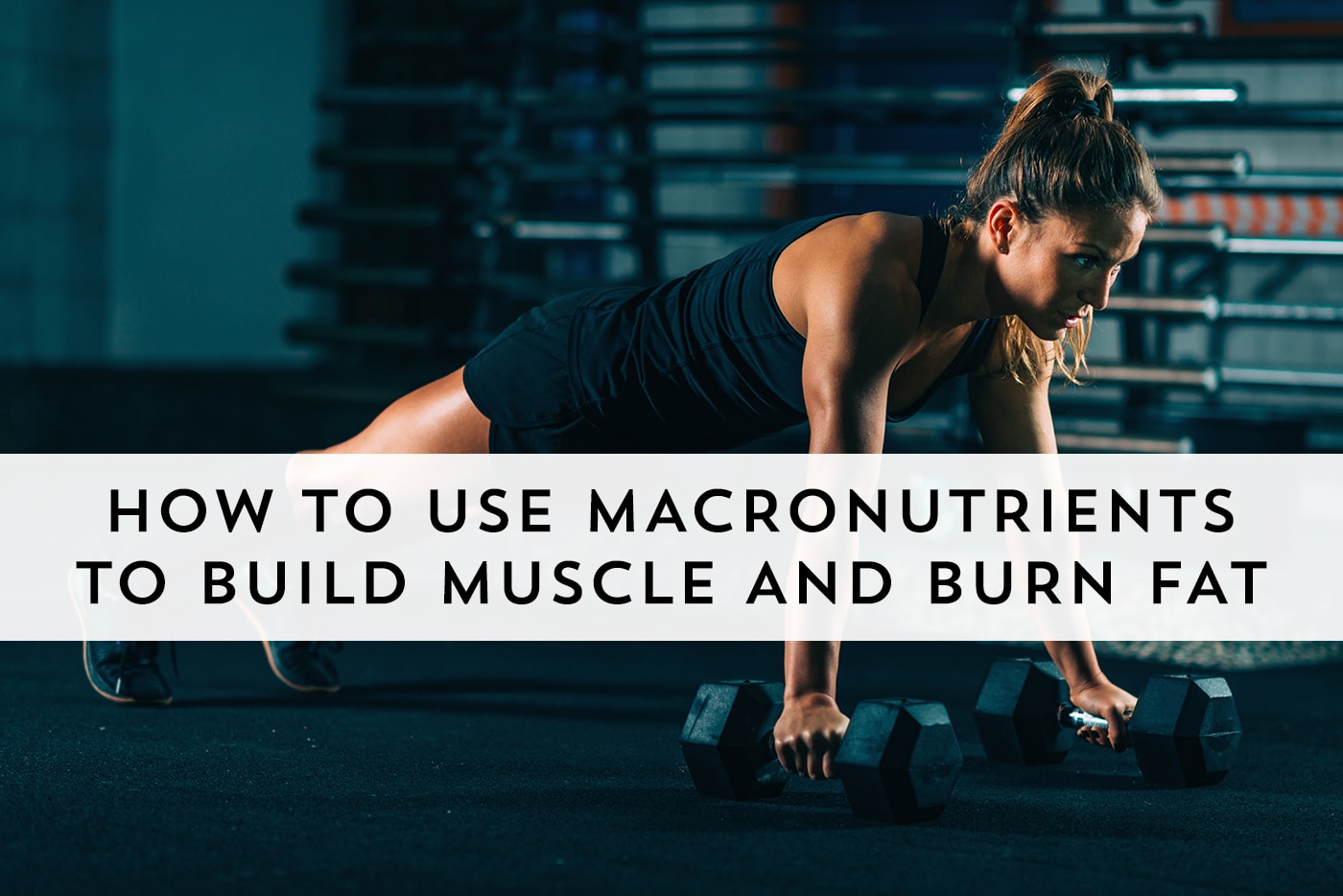
Flexible Plant-Based Dieting: How to Use Macronutrients to Build Muscle and Burn Fat
To most people, weight loss is a mystery. Tens of billions of dollars are spent each year on dieting programs that claim to have found the answer, and yet so few people find success at losing weight and keeping it off.
So why should you listen to us?
Well, we’re 15-plus-year vegans, champion bodybuilders, and the co-founders of PlantBuilt, the largest team of vegan strength athletes in the world. And we’ve helped thousands of clients transform their bodies by building muscle and shedding fat on a plant-based diet.
We understand what it takes to make real change to your body, and want to share that with you in this post.
It starts with one basic fact, despite all the gimmicks surrounding weight loss. And it’s this: No matter what you’re eating or when you eat it, weight loss and weight gain are both determined by caloric balance.
Most people understand this. When we eat more calories than we burn, we gain weight, and when we eat fewer calories than we burn, we lose weight.
But what that means — and this is so important — is that no matter how clean, whole, or unprocessed a food is, if you eat over your caloric maintenance, no matter the source, your weight will increase. (This is why focusing on caloric density is so important for weight loss.)
So it’s no surprise that in the world of body transformations — losing weight, gaining weight, gaining muscle, converting fat into muscle — calories do matter.
But calories aren’t all that matters…
Which macronutrients your calories come from will determine what kind of tissue you gain or lose (in conjunction with your training, of course). For example, you can lose 20 pounds by restricting calories alone, but without planning your macronutrients, and weight training appropriately, the weight lost could easily be coming from muscle. Conversely, you can definitely gain weight by eating a surplus of calories, but without a plan of where they are coming from, and without strength training of some kind, you can easily gain more fat than you intended.
This is where flexible dieting comes in. Flexible dieting isn’t about removing certain foods or limiting what you can eat, but instead is focused on the macronutrients above all else.
And it’s a concept we’ve seen work time and time again with clients, and most importantly, as award winning bodybuilders ourselves.
With a little bit of tracking, focus, and honesty, it can work for you too.
That’s right, there’s a little math involved — but don’t let that frighten you away just yet. Let’s get started with step one, finding your starting point.
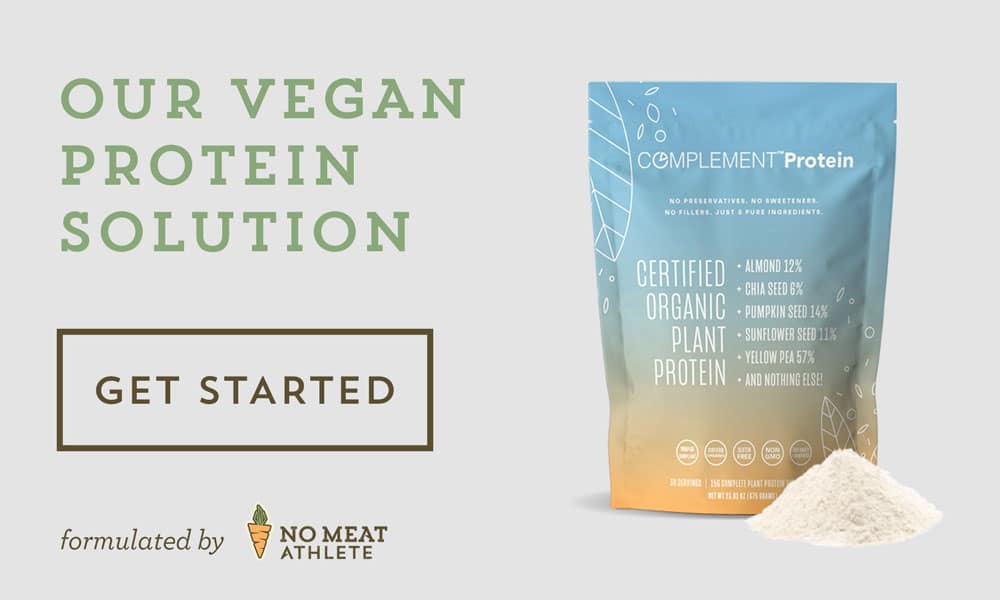
Step 1: Find Your Maintenance Calories
Although humans have the same basic physiology, we’re all unique. You have your own unique lifestyle, sleeping patterns, body fat percentage, age, hormone levels, energy patterns, metabolism, eating habits, etc.
No online calculator will take all of that into account.
This is where maintenance calories come into handy: Your maintenance level of calories is the number of calories you need in order to maintain your weight right now.
And figuring out that number is more simple than you might think:
Simply track what you’re eating right now for one week.
Seriously, if your weight is relatively stable (within a couple-pound range on any given day), whatever you are eating right now is your maintenance caloric level.
And figuring out what that is rather simple:
- Start recording everything you eat and drink. Use an Excel spreadsheet, a notepad on your phone, an app, or even just a pen and paper.
- Record the amounts, the food itself, and the calories. Be as specific as you can be.
- Don’t tweak the numbers, don’t sneak unrecorded food, and don’t try to be “good” just because you’re keeping track. Just eat whatever you normally eat and keep track of it.
- Do this for 7 days and get the average number of calories (add up all of the numbers and divide them by 7).
This is your rough caloric maintenance.
This is the most accurate way to find out where you currently are, calorically and metabolically speaking. This is far more accurate than any calculator on the planet.
But… if tracking is out of the question, you could always use a calculator.
If you really want to get started right away, you can use a calculator to get an estimate of your maintenance calories, but bear in mind, that this will be far less accurate.
Here’s the basic formula:
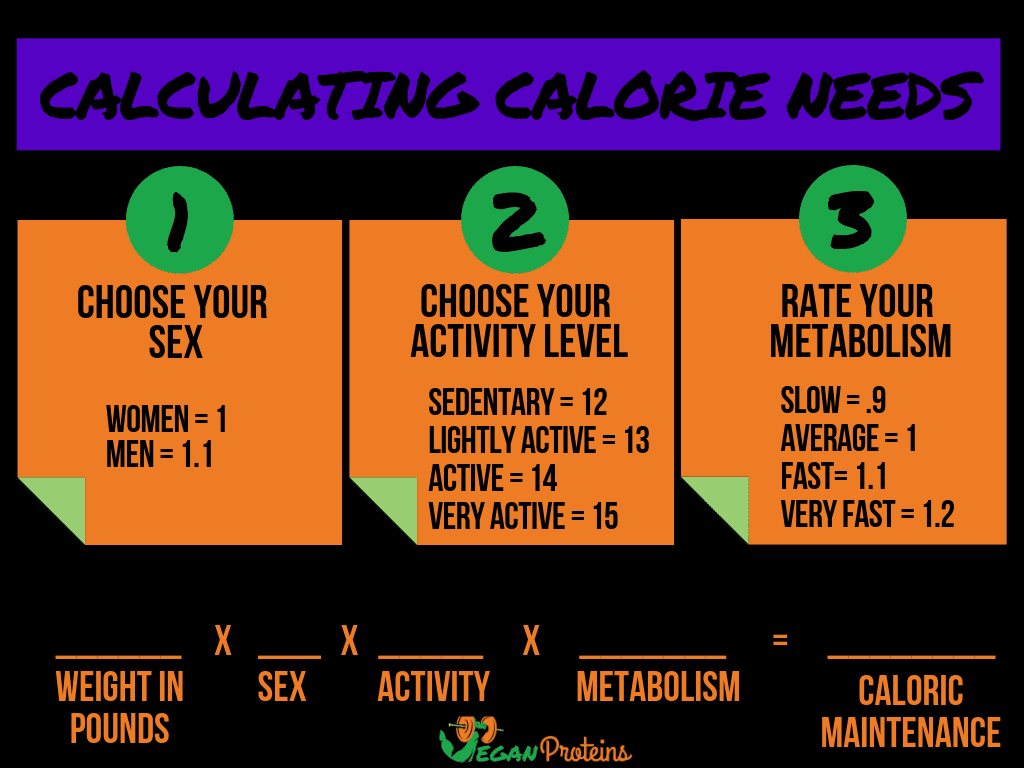
Now that we have determined maintenance calories, it is time for Step 2: Find your deficit for a leaning out phase.
Step 2: Find Your Deficit
Losing body fat means you will need to create a caloric deficit. The larger the deficit, the faster you lose weight, which is an attractive concept for many people — but faster doesn’t always mean better.
The smaller the deficit, the slower you lose weight, but — and this is key — that weight is less likely to be muscle and more likely to be fat loss.
In addition to that, slower weight loss is typically more maintainable, and is longer lasting than crash dieting.
So here’s the deficit rule of thumb:
- Subtract anywhere from 200-600 calories per day from your maintenance calories to set your deficit.
Over the first few weeks, pay close attention to how much weight you are losing. If it’s more than 2 pounds per week, you are almost certainly losing some muscle.
For some people, that might not be a problem, but if you’d like to keep the muscle, then reduce the deficit.
For our example, let’s use a 180-pound man (let’s call him Joe the Example Man), with a maintenance level of calories that is 2400. He wants to enter a fat loss phase at a moderate pace.
Therefore Joe the Example Man’s calorie calculation would be:
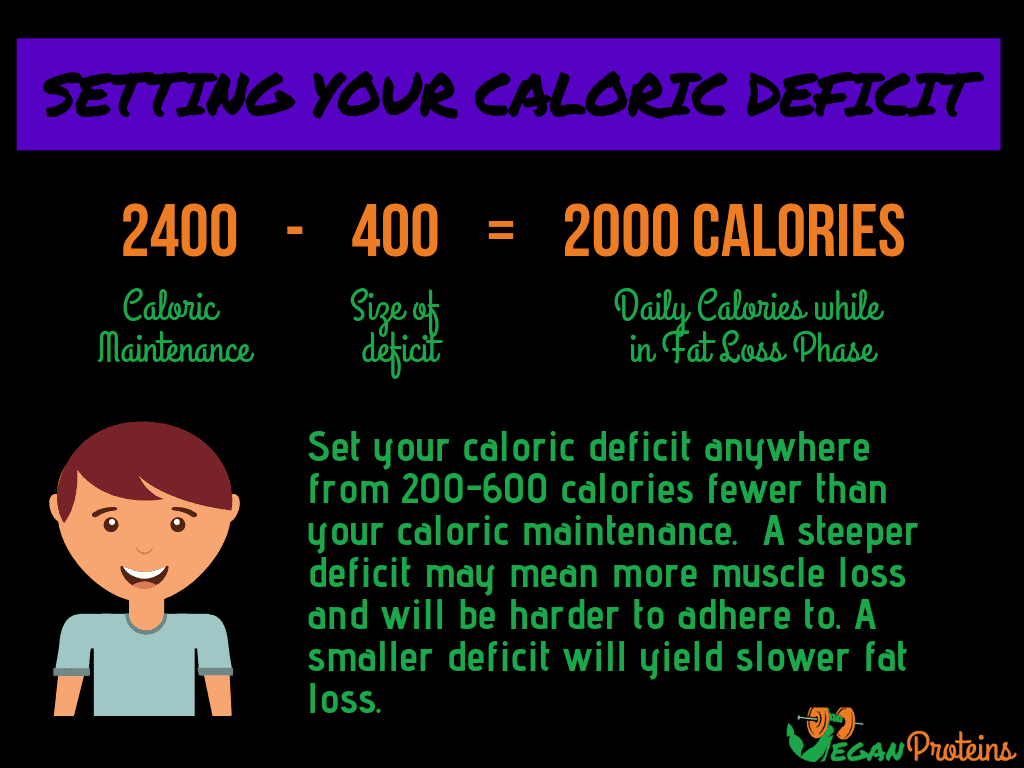
With your baseline numbers set, it’s time to begin setting up a plan to hit your goal weight. And to do that, we need to look at the macros.
Step 3: Calculate Your Macros
Your macronutrient numbers will give framework to the types of foods you eat, and provide you with the right ratios of protein, fat, carbohydrates, and fiber.
Let’s start with protein:
Protein
Protein is the first macronutrient you should calculate, and the amount of protein you require is based on your lean body mass. To determine this, you will need to estimate your body fat percentage. It doesn’t need to be exact, as almost no method will give you a perfectly accurate measurement, but it’s important to be honest with yourself in order to be as accurate as possible.
Here are a few ways you could go about finding your rough body fat calculations:
- Go to a nearby gym and see if a trainer can measure you with
calipers . - Order a pair of
calipers online and learn how to measure yourself. - Use this picture as a rough estimate – it does NOT have to be exact.
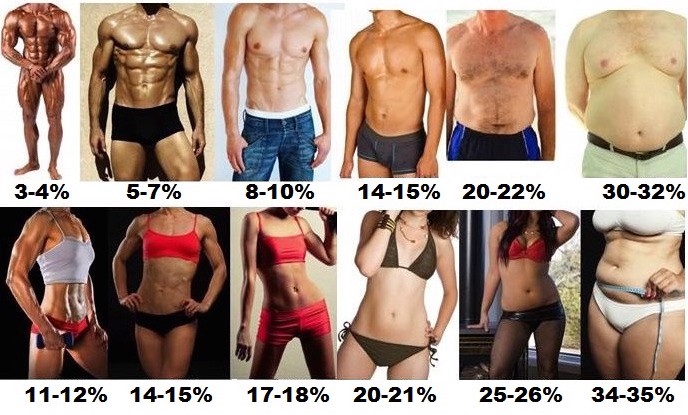
Once you have your rough body fat percentage, get ready for some fun math:
- Multiply your body fat percentage by your weight in pounds.
- Subtract your answer from your weight.
What you are left with is your lean body mass (LBM), or the fat free mass in your body. This is skeletal muscle, bone, connective tissue, blood, and organs.
For a fat loss, muscle gain body transformation, you should be aiming to get anywhere from .7-1.2g of protein per pound of lean body mass, depending on your preferences.
Note: If you’ve never focused on gaining muscle before, this is probably a lot more than what you’re getting now, and more than we typically recommend for the average person. This protein target is for people focused on a body transformation. A simple way to add additional protein is through a plant-based protein powder like Complement Protein.
This is a fairly large range, and where you decide to fall in that range can be determined by the foods you already like, what you need in order to recover properly from workouts, and what you need in order to feel satisfied. But anywhere in this range will work. If you currently eat very little protein, try staying at the lower end, but if you already eat about .7g per pound of LBM, try bumping it up a bit and see how you feel.
Let’s take Joe, who is going into a fat loss phase and estimates himself to be about 18% body fat. His calculation would look something like this:
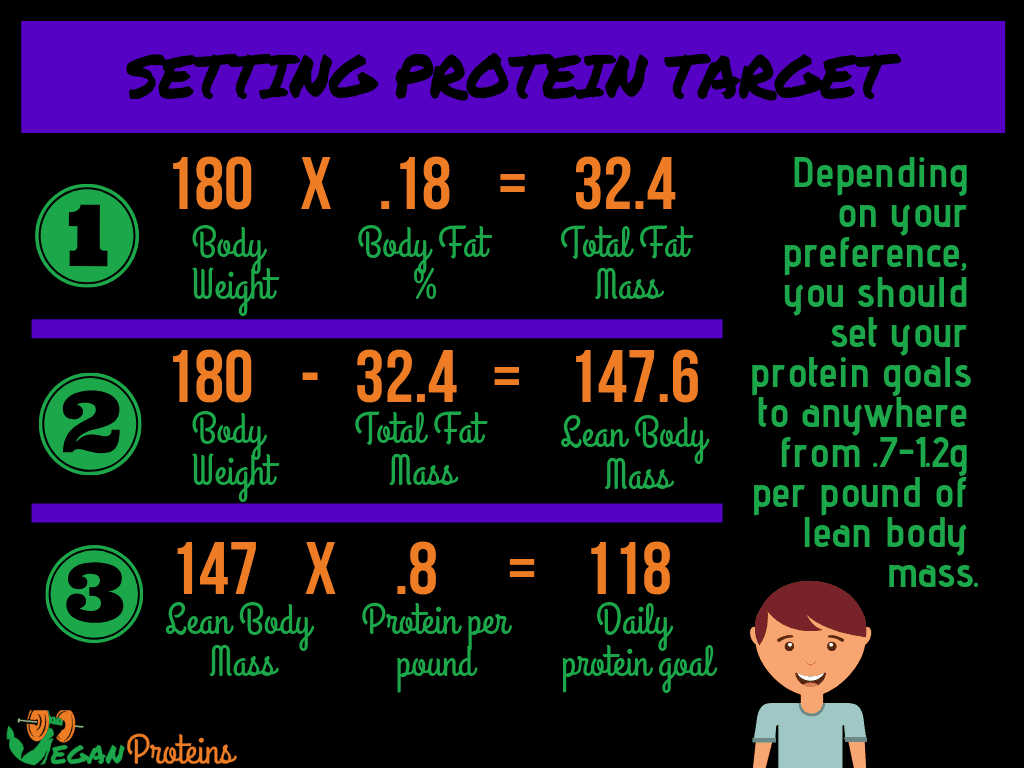
Pro Tip: Many people can stop right here! If you’re brand new to tracking your food and are already feeling overwhelmed by all of these numbers, you can focus on these two numbers to start: your calories and your protein.
If you can hit these two numbers regularly, you are in a great place, and you will likely see results from this alone. As you become more confident in the process of tracking and reaching your protein goals, then you can start calculating your carbs and fats and trying to reach those numbers as well. But there is no need to rush things. You are more likely to succeed if you take it one manageable step at a time rather than ambushing yourself with a dozen new meticulous goals.
But if you’re ready to get into more details, the next step is to calculate your fat requirements.

Fat
Fat should be the second macronutrient to calculate, just for simplicity’s sake. Determining your fat requirements will be dependent on your preferences. Which do you prefer: carbs or fats? Because the more fat you have, the fewer carbohydrates you will get and vice versa.
So ask yourself: What makes you feel the most satisfied? Which gives you better workouts? Better sleep? Better focus in your daily life? These are important questions to ask if you’ve never thought about it before, but once you’ve been practicing flexible dieting for a little while, you will start to figure out the answers for yourself.
If you’re scratching your head over this one, I will say that you can safely fall anywhere in the range of having 20- 40% of your calories coming from fat. For hormonal health reasons, and the absorption of fat-soluble vitamins, I would not recommend going below 30g fat, no matter what.
Checking in on Joe, it turns out that he likes fat, but he’s not crazy about it. He may calculate in the middle of the range, like so:
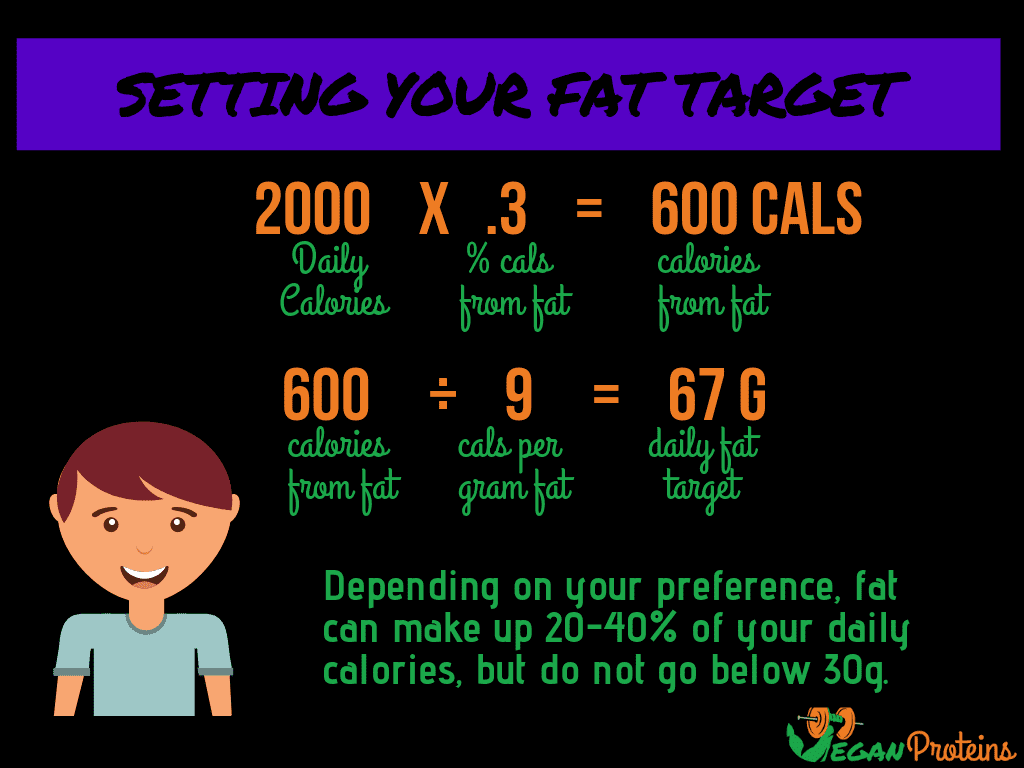
Next up: A very popular topic of conversation, carbohydrates.
Carbohydrates
The most manipulated macro will almost always be carbohydrates.
Carbs can be manipulated in many ways to stimulate fat-loss, aid in recovery, and to give you immediate energy when needed, to boost hormone levels, and to give you killer workouts.
So, there’s a lot we can do with carbs. For our purposes at this point, we are going to fill our remaining calories with carbs. How we do this will require the most math you will need to do in this whole process. (It’s not that bad though, I promise.)
- Combine your calories from protein (by multiplying the grams by 4) with the calories from fat (by multiplying those grams by 9)
- Subtract that number from your total daily calories.The remaining number is the amount of calories you’ll get from carbohydrates.
- Divide this number by 4 (the number of calories per gram of carbohydrates) and you have your carbohydrate goal, in grams, for the day.
In simpler terms:
(Protein x 4) + (Fat x 9) = Calories from protein and fat
Total calories – Protein and Fat calories = Carb calories
Carb calories ÷ 4 = Carbohydrate grams
If that was confusing, here’s Joe to show us how it’s done.
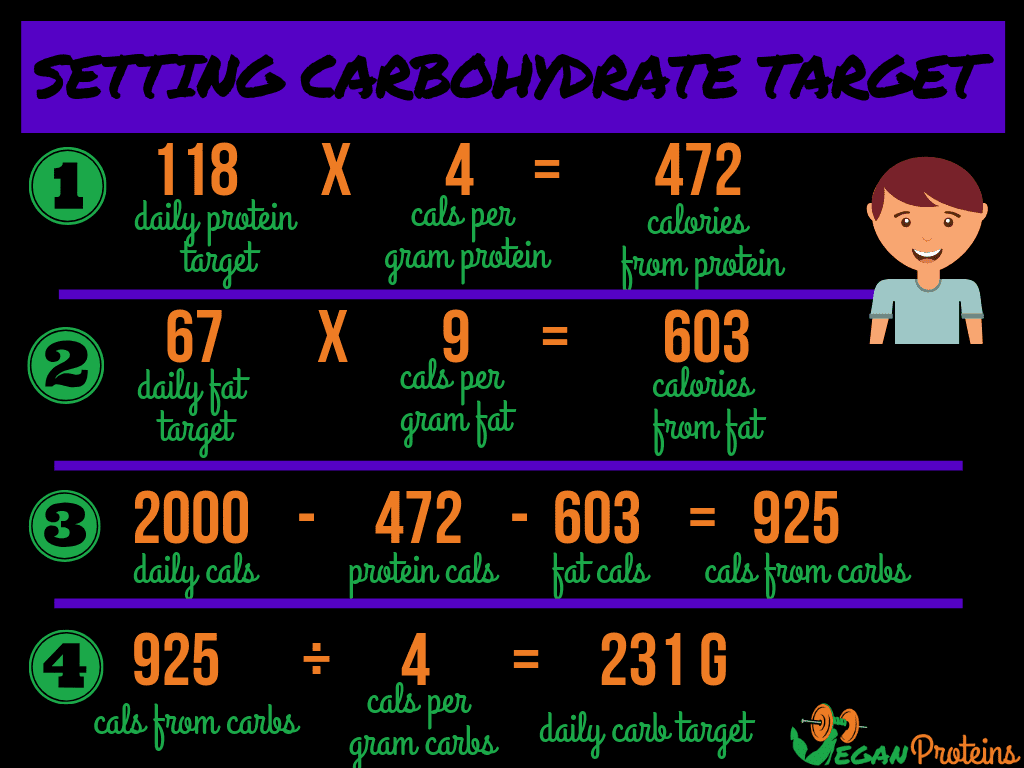
That just leaves one macronutrient: Fiber. This is not a difficult nutrient for vegans.
Fiber
We won’t take up much space on this one because vegans get plenty of fiber. However, let’s just say that you should aim for 14g of fiber per 1000 calories as a minimum.
For Joe who is consuming 2000 calories per day, this would be 28g.
You should establish an upper limit for yourself as well, and this will vary from person to person, so pay attention to your body’s reactions. As a general guideline though, I like to keep my cap at no more that 30g per 1000 calories. For Joe, this would be 60g. The most important thing about fiber is to be fairly consistent with how much you have every day. Try to eat in about a 10g range on most days.
And there we have established the baseline macros for your goals! Now, what do we do with these three numbers?
Note: Ready to get started? Use our free Macronutrient Cheat Sheet for a quick reference guide to 85 of the most common plant-based foods.
Step 4: Begin Logging Your Food
There’s nothing glamorous about tracking your food. It’s tedious, and it gets old fast. I’d be lying if I told you otherwise.
But, and this is a big but, it is crucial to track your food with flexible dieting, especially while you are learning how to do it.
If you’ve never tracked your eating habits before, this could be a big eye opener for you. Many people do not even realize how much they have been over-eating, or under-eating. Most people have no idea what their food is actually composed of, so tracking your food for long enough can teach you a lot about yourself both physically and mentally.
Measuring cups vs scales
For accuracy, we recommend using a food scale rather than relying only on measuring spoons or cups.
Measuring cups can vary when measuring food, depending on whether it’s a level scoop, or how much the food has settled in a package, or even how the food is chopped. The scale, however, does not lie.
Case in point: Weigh out 16 g of peanut butter on the scale. Then, measure a tablespoon of peanut butter in a measuring spoon and weigh that. I bet you dollars to donuts that the one in the measuring spoon weighs more.
You will need to regularly use a food scale, at least until you get accustomed to what food serving sizes look like. This may take a while. You can test yourself along the way by guessing and then putting a portion on the scale to see how close you are. (See? Just turn it into a game!).
You’ll be shocked at how accurately you can guess with enough practice. You can use measuring cups for liquids, but for solid foods, the scale is much more accurate than measuring cups.
There are two key points to being successful with food tracking:
- Consistency: Being consistent with your food tracking is so, so, so important in achieving the results you’re going for, especially in the beginning. Every time you weigh and log something, it is practice. Like anything else, you have to put in the effort until you really “get it.” Also, tracking everything helps you to hold yourself accountable. You’re far less likely to sit on the couch and plow through a bag of chips if you know you’re going to have to record it.
- Recording honestly: Food logging will be a wasted effort if you’re not being honest about what you’re eating. You can’t play the “if I didn’t log it, it didn’t happen” game and expect to get the results you want. Snacking while you’re cooking, the beer you had out with your pals, and that heap of BBQ sauce you put on your tofu — yeah, that all counts, so you should track it.
Also, do you know what five ounces of tofu looks like? Most people don’t, and that makes sense; why would they? But guessing how much something weighs by eyeballing it can throw you way off your whole day’s goals, especially if you do it regularly. That could easily set you back a week. Accuracy is crucial, so use your scale whenever you can until you’re an estimating pro.
Apps vs pen and paper
The way you decide to track your food is up to you, but we can’t speak highly enough about the My Fitness Pal (MFP) app, which you can download for free to any smartphone, or use on a desktop.
Disclaimer: Don’t EVER, under any circumstances, use the preset macronutrient or caloric “suggestions” that MFP gives you after you punch in your body weight, age, goals, etc. They are wrong, always.
My Fitness Pal has an incredible amount of versatility, and once you’ve logged a few days of food, it gets easier and easier. The food database alone makes it worthwhile; it contains nearly everything. We can count the number of times on one hand that it hasn’t had a food that we were looking for in its database, including things like meals from certain restaurants, like Veggie Grill.
There are many ways to enter foods, depending on how precise you want to be. You can enter foods based on “serving sizes” as suggested on the labels, or you can enter foods in units such as “medium apple.” Because we like to be as precise as possible, we like to enter any food that doesn’t come out of a package in grams, which is the most accurate method. The easiest way to find food in grams is to just search for the food with the word “grams” after it. For example, if you want to find cooked brown rice in grams, you would type “brown rice cooked grams” into the search bar.
You can add your own recipes, you can scan barcodes of pre-packaged foods, you can save meals that you frequently have, and you can copy meals from previous days. It’s very easy on the user, and I’m all about user-friendly things that make my life easier.
Step 5: Have a Plan of Attack
Although flexible dieting is about being, well, flexible, having at least a loose plan is going to be incredibly helpful to your success.
Whether you want to plan your food a day in advance or a full week in advance, flexible dieting still allows you the freedom to work in the foods that you enjoy. Trying to wing it from the get-go, however, is a recipe for failure when you’re learning. Slow down there, cowboy.
Joe the Example Man personally likes to plan his daily meals in the morning, but many people like to do it the night before. Joe pretty much always eats the same thing for breakfast (creature of habit), and then takes about 5 minutes to plan the rest of his day. This way, he has a plan, and if it changes a little bit, it’s easy to manipulate a few grams here and there, but overall, he knows what he’s going to do.
Putting your food into My Fitness Pal a day, or even a week in advance is also great because, once it’s logged, you’re much more likely to eat it.
As you get used to it, buying groceries becomes both more fun than eating a strict meal plan, and also allows you to not buy a bunch of extras because you already have a rough idea of what you’re going to eat.
Use a “good, better, best” approach when needed.
When first attempting a flexible dieting lifestyle, it can be overwhelming for some to have so many numbers to think about. For this reason, we recommend a “good, better, best” approach if things feel like they’re getting out of hand:
Best: Sticking to the plan you’ve made.
Better: Hit the protein and calories goal. (Even if carbs and fats are a little off, you’ll still make progress by hitting protein and calories goals)
Good: Hit that calorie goal, within a 100-calorie range. It’s important to remember that even the “good” tier will yield weight loss results.
A Little Work Goes a Long Way
Body transformation is work, for sure. I’d be lying if I said doing exactly what you do now will produce the results you want (if it were that easy, you’d already have the results…).
It takes tracking, honesty, and a little bit of math here and there.
But if you put all those pieces together, you’ll be on your way to achieving whatever goal you’ve set for yourself — whether that’s losing weight or building muscle.
Plus you’ll have the added benefit of knowing what you’re putting in your body on a day-to-day basis, which is always a good thing.
To make your life easier, we’ve put together a quick reference Macronutrient Cheat Sheet which explains everything listed here, plus a quick reference macro guide on common plant-based foods, and two sample meal blueprints for shaping meals to your needs.
Get the Macronutrient Cheat Sheet here.

About the Authors: Giacomo and Dani co-founded VeganProteins, an online supplement store and coaching business which has helped over 1,000 athletes gain muscle and lose fat on the vegan diet. They’ve teamed up with NMA to produce the brand new Plant-Based Body Transformation, a guide to gaining muscle and losing weight on a plant-based diet.
Leave a Reply
Thank you for this!!! I’ve been trying to lose weight and lift at the same time, but I have not been able to find such a good breakdown before. All the lifting people think protein is king, and all the plant based people are like… nah, just eat and it will come, and those people have not been overweight like me, so they don’t have the point of reference I need. Thank you. I was already using MFP, but I adjusted my macros a bit based on your suggestions here. My fat cals are now at 30g. 🙂
Just love all the tips (and they where so important to me and clear)!!
It seems i only eat 1021 cal per day.
Protein 75.2 cal
Fat 306.3 cal
Carbohy 76.75 cal
Fibre 14gr
It somehow seems so little compaired to others. Should i go about the calculations or should i change something?
This was a great and informative article about all of this. Thank you for making it easy to understand and full of valuable information.
This was way more helpful than most macro calculation articles. It was short and sweet and the graphics helped me understand better. My attempts at this in the past have been disuaded by lengthy explanations. I love what you all do for our community! Keep up the great work!
I thought this was a great read. I’ve been tracking macros for some time now, and used your calculations to find they are pretty similar to where I am. MFP is an awesome tool for tracking. My biggest issue is trying to get enough plant based protein without going way over carb intake. Beans and legumes are good source of protein but the carbs add up fast. For this reason I include a lot of fish and eggs. Any suggestions?
-
Kate! I read your comment and this is exactly my problem, too!! I had to check to make sure it wasn’t a comment I posted a while ago and forgot about. Have you come up with any solutions?
-
Hi! I totally feel you!
But I have recently discovered that adding a lot of veggies to my meals helps with this. But really, a lot of veggies, more then I thought I should be eating. And I put beans and legumes in carb category, not into protein. Instead Tofu, Tempeh, Seitan etc. – into protein. Adding up more vegetables (really a lot!!) will help.
As example : have 100gr of Tempeh, 200gr of broccoli, 90gr of champignon, 200gr of potatoes – (plus add extra healthy fats of your choice) and you will have a meal low in kcal, but with at least 35 gr of protein, and only around 50 gr carbs.
Try playing around with the measuring program.
And I also found helpful Chef AJ lecture about calorie density.
-
How about the calories you burn durong excersice? Do you take that into account or just continue hitting the calories and macros goals regardless of the exercise done?
I’ve seen explanations of this elsewhere and think this one is the most clear and comprehensive. Nicely done!





This is brilliant guys, thanks so much for this. I love the way you calculate maintenance calories too using what you actually eat in a week if your weight is relatively stable – I’ve not seen this before. Online calculators tell me to go with 1200 calories when I’m currently consuming around 2200 per day! My body fat is around 25%. Dropping down to 1200 would make me one grumpy girl with no motivation/fuel to train the way I do. Thanks again!